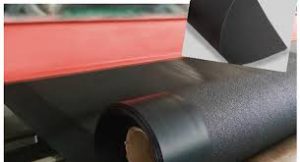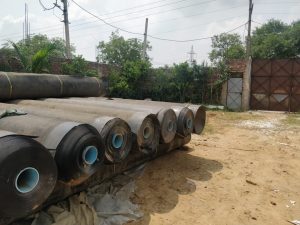NWR Doubling Project, KTWS–NNL, Mahendragarh, Haryana
Introduction
The North Western Railway (NWR) Doubling Project at KTWS–NNL in Mahendragarh, Haryana, is a critical infrastructure development aimed at enhancing railway capacity, reducing congestion, and improving efficiency in freight and passenger movement. As part of this large-scale project, Ocean Non Wovens had the opportunity to contribute by supplying and installing 10,000 SQM of Geocell 660×75, a product specifically designed for soil stabilization, erosion control, and load distribution in demanding environments like railway embankments.
Table of Contents
Project Background
The Indian Railways has been prioritizing track doubling projects to accommodate growing traffic. According to the Ministry of Railways, more than 8,000 km of track-doubling works have been commissioned in the past decade, significantly reducing delays and enabling faster operations [Source: Indian Railways Annual Report 2024].
The KTWS–NNL stretch in Mahendragarh, Haryana, is a vital link under the NWR zone. Doubling this section ensures seamless connectivity for both freight and passenger trains, catering to the region’s industrial and agricultural outputs. However, the project came with a set of engineering challenges—the soil conditions, load-bearing capacity, and embankment stability required a reliable geosynthetic solution.
Why Geocell Was Chosen
For the NWR Doubling Project, the selection of Geocell 660×75 was not incidental—it was based on several engineering needs:
- Soil Stabilization: Railway embankments are prone to differential settlement and erosion. Geocells provide a three-dimensional honeycomb structure that confines and strengthens infill material, thereby improving subgrade stability.
- Load Distribution: The heavy axle loads of freight trains (25–32.5 tons/axle) require uniform stress distribution. Geocells help in dispersing these loads, minimizing deformation and rutting [Source: ISRM Geotechnical Studies, 2023].
- Cost Efficiency: Compared to traditional methods like granular sub-base thickening, geocells reduce material consumption while improving performance. This was a crucial factor in a large-scale public infrastructure project.
- Sustainability: With increasing focus on green infrastructure, geocells reduce the carbon footprint by lowering the volume of quarried aggregates required for embankment strengthening.
Technical Aspects of Geocell 660×75
The Geocell 660×75 supplied by Ocean Non Wovens is a high-density polyethylene (HDPE)-based cellular confinement system.
- Cell Depth: 75 mm
- Cell Size: 660 mm
- Material: Virgin HDPE with UV stabilization
- Performance Standards: Compliant with ASTM D standards for tensile strength, seam peel strength, and durability
This configuration is particularly effective for:
- Railway track beds
- Embankment protection
- Load-bearing platforms
- Erosion control on slopes
The 10,000 SQM installation for the NWR project was strategically spread across embankment reinforcement zones where soil erosion and settlement risks were higher.
Unique Insights from the Project (What Others Don’t Talk About)
Most case studies discuss only supply and installation, but here are some lesser-discussed insights from this project:
- Seasonal Challenges: Mahendragarh experiences extreme summers (up to 47°C) and semi-arid conditions, which significantly impact soil shrinkage and cracking. Geocells helped mitigate this by providing confinement even during soil contraction phases.
- Subgrade Variability: The project area had mixed soil composition—silty clay and sandy loam—which posed difficulties for uniform compaction. The use of Geocell 660×75 allowed for effective utilization of locally available soil, reducing the need for imported granular fill.
- Drainage Integration: Poor drainage is a common cause of track settlement. During installation, perforated geocells were used in sections prone to waterlogging, which improved both stability and long-term durability of the track structure.
- Life-Cycle Benefits: Conventional embankment reinforcement typically requires frequent maintenance. With geocells, the expected maintenance cycle is extended by 30–40%, reducing long-term operational costs for Indian Railways.
Impact of Geocell in the NWR Doubling Project
The installation of 10,000 SQM of Geocell 660×75 delivered measurable benefits:
- Enhanced Stability: Track embankments achieved higher load-bearing capacity with reduced settlement.
- Faster Construction: Railway authorities reported a 15–20% reduction in construction time due to ease of installation and reduced need for additional fill material.
- Sustainability Gains: The use of locally available soil saved approximately 2,500 tons of aggregates, lowering both costs and environmental impact.
- Improved Safety: Stable embankments directly contribute to smoother and safer train operations, minimizing derailment risks.
Conclusion & Promotional Note
The NWR Doubling Project at KTWS–NNL in Mahendragarh, Haryana, stands as a successful example of how advanced geosynthetics like Geocell 660×75 can redefine infrastructure development. By supplying and installing 10,000 SQM of geocells, Ocean Non Wovens not only contributed to railway modernization but also demonstrated how sustainable engineering solutions can reduce costs, improve performance, and extend infrastructure lifespan.
At Ocean Non Wovens, we specialize in manufacturing and supplying high-quality geosynthetics solutions—from geotextiles, geomembranes, and geocells to erosion control systems. With decades of expertise, we ensure that every project we handle delivers performance, durability, and sustainability. If you are planning an infrastructure project—be it railways, highways, reservoirs, or landfills—reach out to us to explore how our products can add unmatched value.



